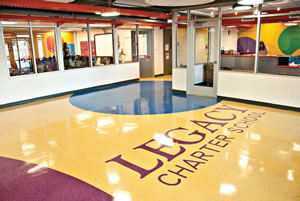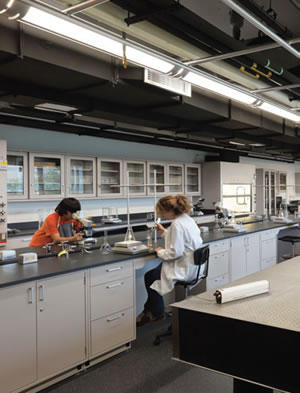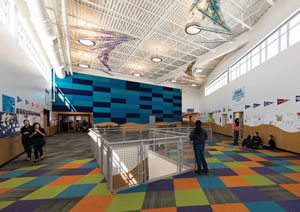Choice Arguments
- By Michael Fickes
- 10/01/14

PHOTOS © LEGACY CHARTER SCHOOL
Recent polls have surveyed public attitudes toward school voucher and charter school programs.
Last year, a Gallup poll found that 70 percent of Americans opposed school vouchers, the highest percentage in two decades of polling on the question.
The public’s view of charter schools is positive. A 2014 Gallup poll found that support for charter schools rose to 70 percent, up from 68 percent in 2013.
Within the world of education, however, there is much less unanimity about vouchers and charter schools. Choice proponents and opponents are passionately intense in their beliefs.
What are vouchers and charter schools? Do they work? Who supports and promotes choice? What is the alternative to choice? Who supports that?
Do Vouchers Work?
School vouchers are grants of state tax dollars that parents may use to pay tuition at private schools.
And voucher use is growing. Estimates put the number of students using vouchers at 245,000 in 16 states and the District of Columbia.
At the same time, vouchers have become one of the most hotly contested school choice issues. Conservatives typically praise the success of vouchers, while liberals call the various programs abject failures.
The American Federation for Children (AFC) supports state-level efforts to provide low-income and middle class families with access to private school choice through vouchers, charter schools and other choice media.
According to AFC, research has demonstrated that vouchers lead to high parental satisfaction rates, increase student achievement, boost graduation rates and help public schools improve.

JIM STEINKAMP/STEINKAMP PHOTOGRAPHY
How does the parental satisfaction rate square with the Gallup Poll finding that 70 percent of Americans oppose school vouchers? School choice proponents say that Gallup’s ties to teachers’ unions, which oppose vouchers, lead the pollster to ask biased questions when polling about vouchers. Fair and unbiased questions, contend choice proponents, lead to findings of overwhelming support.
The Friedman Foundation for Choice website — Economist Milton Friedman originated the voucher idea in 1955 — offers a page summarizing research into school vouchers. Of 10 empirical studies examining how vouchers affected students, nine found that vouchers improve student outcomes, six found that all students benefit and three found that some benefit and some are not affected. One student found no visible impact. None of the studies suggested negative effects.
Voucher opponents include the American Federation of Teachers (AFT), the National Education Association (NEA) and AASA — The school superintendents association.
“The AFT is opposed to vouchers, which provide public dollars for private school tuition,” says Randi Weingarten, president of AFT. “Not a single credible study in the nearly 25-year history of vouchers concludes that vouchers help improve student achievement.
“In fact, children in voucher programs perform the same as or worse than their public school counterparts. The time and public funding devoted to vouchers could be used far more productively to invest in safe and welcoming neighborhood public schools that provide a rich curriculum, the resources, time and trust educators need to do their jobs; wraparound services to meet disadvantaged students’ social, emotional and health needs and early childhood education.”
The NEA agrees, adding that about 85 percent of private schools are religious, making vouchers a means of circumventing the constitutional prohibitions against subsidizing religious practice and instruction.
AASA recently issued a question and answer article, talking points and suggested letters-to-the editor against vouchers to all of its members.
Among the AASA points is the assertion that voucher research has not definitively shown that vouchers, which are also referred to as opportunity scholarships, lead to improved educational performance. For instance, annual evaluations of the Washington, D.C., Opportunity Scholarship Program have consistently shown an increase in graduation rates and parental satisfaction but no effects on student achievement or student satisfaction.
Research into the effectiveness of Milwaukee’s program, continues the AASA, also shows that voucher student test scores lag behind public school students’ scores.
Indeed, the proponents and opponents of vouchers do not pull any punches. Each side believes intensely that the other side is wrong.

DLR GROUP/LACASSE PHOTOGRAPHY
Do Charter Schools Work?
There is a similar division of opinion concerning charter schools.
“Charter schools are defined in both federal and state law, and the definitions in state laws vary,” says Nina Rees, CEO of the the Washington, D.C.-based National Alliance for Public Charter Schools (NAPCS), “Charter schools are independent, public and tuition-free schools that are being given the freedom to be more innovative while being held accountable for advancing student achievement.”
Charter schools have been around since the 1990s. The enactment of No Child Left Behind during the George W. Bush administration and, later, President Obama’s Race to the Top program supercharged the growth of charter schools.
According to NAPCS, about 2.5 million students attend more than 6,400 charter schools in 40 states and Washington, D.C., today.
Charter schools now span 42 states, up from 40 last year. The State of Washington and Maine recently enacted legislation to inaugurate charter school programs. Programs in those states will raise the numbers of charter schools and charter school students next year.
The non-profit NAPCS is a vigorous proponent of charter schools. “We are committed to advancing the public charter school movement,” says CEO Rees. “We work at both the state and federal level to advocate for policies to support the growth and expansion of high-quality charter schools. We work closely with state charter school organizations.”
A recent NAPCS report reviews 13 studies of charter school performance conducted between 2010 and 2013. The review covered 13 studies, three national and 10 from various states. Each reported positive academic performance results for students in public charter schools compared to peers attending traditional public schools.
The NAPCS report notes that just one study found neutral or negative results since 2010. That research looked at charter schools in Utah.
The Center for Research on Education Outcomes (CREDO) at Stanford University released the results of the largest charter school study to date last year: The National Charter School Study, 2013. It is the second CREDO study. The first came out in 2009 and looked at charter school performance in 16 states.
The 2013 research covered charters in 26 states and the District of Columbia. Those states and Washington, D.C., accounted for more than 95 percent of charter school students in the United States during the 2012-2013 school year.
The overall 2013 results indicated that charter school students scored 0.01 standard deviations higher than traditional public school students on standardized reading tests. Charter school students’ math scores were 0.005 standard deviations lower on math tests than traditional public school students.
For those who don’t understand statistical terms like standard deviations, the CREDO reports estimates that 0.01 standard deviations translates into an additional seven or eight days of learning in the course of the year. So charter school students’ receive seven or eight more days of learning in reading per year and three or four days less math learning.
According to a review of the CREDO study carried out by the National Education Policy Center (NEPC) in the School of Education at the University of Colorado in Boulder, the study suggests that there is virtually no overall difference in the performance of charter schools and traditional public schools.
In fact, there were significant variations between charter school and traditional public school performance from state to state. In other words, some states appear to have significantly better charter school systems than others.
In addition, students living in poverty and Hispanic English Language Learners performed better than the overall averages, but white students, Asian students and non-English Language Learner Hispanic students performed slightly worse.
If There’s No Difference, Why Have Charter Schools?
If there is little to no difference between the performance of students at charter schools and traditional public schools, why spend public money on charters? Why not spend on improving existing schools?
That’s exactly what we should do, says Diane Ravitch, research professor of Education at New York University and a foe of choice and charter schools, especially those operated for profit. Ravitch has authored a number of books about choice. The latest is her 2013 work “Reign of Error: The Hoax of the Privatization Movement and the Danger to America’s Public Schools.
In “Reign of Error,” Ravitch argues that choice tools like vouchers and charter schools are a conservative effort to privatize the public school system. “What began as a movement for testing and accountability has turned into a privatization movement,” she writes.
Observers agree. Some have called the choice and charter school movement a Trojan horse — something that looks like a gift but is really designed to destroy.
Choice proponents, of course, deny such claims and cite research that proves choice innovations outperform traditional public schools.
But there is a third way, and you might be surprised at who supports it: among others, the American Federation of Teachers (AFT).
“Charter schools were originally envisioned — by former AFT President Albert Shanker, — as a laboratory for innovative teaching and as places where teachers would be active participants, through their unions, in the decision-making and operation of the school,” says the AFT’s Weingarten.
“Today’s charter schools are very different, with only a small minority that can be labeled as incubators for innovation and as places that respect teachers’ voice,” she continues. “The charter schools that are living up to the original promise have innovative academic programs and unionized teachers with a voice in their schools.
“Overall, charter schools need more public oversight and regulation as well as more parental and teacher input to ensure that they are financially and academically responsible.”
In short, the third way is to make all schools better, charter schools as well as traditional public schools.
This article originally appeared in the issue of .